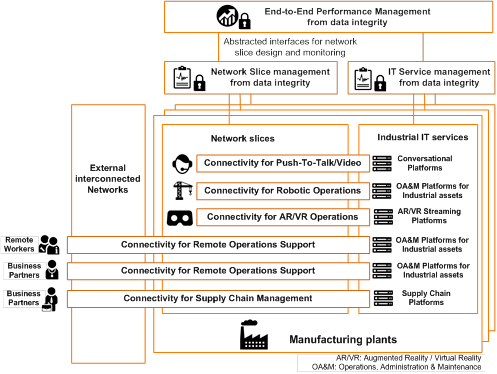Network Slicing and Blockchain to Support the Transformation of Connectivity Services in the Manufacturing Industry
Nicolas Bihannic, Orange Labs, Thierry Lejkin, Orange Labs, Isabelle Finkler, Orange Business Services and Alexis Frerejean, Orange Business Services
IEEE Softwarization, March 2018
Abstract—this article illustrates how a strong coupling of network slicing with Information Technologies (IT) assets can respond to the forthcoming business transformation of the manufacturing market. It is also presenting how enhanced-assurance services can be provided especially with the integration of the emerging and promising blockchain technology.
Keywords —network slicing, 5G, industry 4.0, data integrity, blockchain
I. Introduction
In the 3GPP vision, “network slicing enables the operator to create networks customized to provide optimized solutions for different market scenarios which demand diverse requirements, e.g. in the areas of functionality, performance and isolation” [1]. Network slicing can be fully implemented with the combination of three properties: network softwarization, a better granularity in the definition of functions composing the 5G system, and a larger distribution of datacenters especially at the edge of networks. This network capability is particularly important for addressing B2B markets, also called verticals, like industry, healthcare, smart cities and territories, smart grids, or transportations [2]. For the future of the industry, also known as the industry 4.0 or industrial Internet, the main expected gains are to enhance operational efficiency, to improve logistics and traceability, and to accelerate innovation and collaboration. Other expected benefits with process and service digitization are to customize the design and manufacturing of products, as well as to have a seamless follow-up of the product lifecycle (throughout its design, production, distribution, usage, maintenance and recycle stage) [3]. These transformations have thus an important impact on tools, objects, sensors, machines and people in the area of production. Moreover it concerns all industrial sectors and all companies irrespective of their size [4]. Lastly, all those objectives can only be fully achieved when setting data-driven processes for both connectivity and Information Technology (IT) assets management. Moreover, the integrity of those network and IT originated data is essential for Orange to engage in such business critical services as later shown in section V. The overall architecture shown in Figure 1 presents this variety of involved players and usages that result in tailored connectivity services, a strong integration of network slices with IT assets, and the need for data integrity for enhanced-assurance services and performance management.

Figure 1: Network slicing management in the overall system for the manufacturing industry
II. Building of tailored connectivityConnectivity requirements are particularly complex for the industry 4.0 in terms of coverage footprint (e.g. indoor and outdoor), mix of technologies (e.g. based on licensed and unlicensed spectrum), and roadmap alignment with lifecycle management of connected industrial assets and goods. Indeed, manufacturing plants for a given company are likely to be located in several countries like in automotive industry [5], and the overall security must also be guaranteed across those different operator’s administrative domains. Connectivity services must also support the concept of a secure extended factory in where remote workers, external partners and even surrounding partnering factories connect to the industry plant even for usage that can be considered as critical in terms of security and safety in a business perspective.
In order to streamline internal processes from the manufacturing customer perspective, Orange is requested to support as much as possible, in such multi-country context, the reuse of the same deployment and management processes for connectivity services regardless the country. The evolution of mobile architecture towards model-driven implementation for network management and orchestration must contribute to reach this goal.
III. Enhancing network slicing value with IT assetsConnectivity and IT assets (e.g. assets/goods tracking, artificial intelligence for preventive maintenance, Push-To-Talk/Video/Data services) must be more and more integrated in the digitization journey of each vertical market. Indeed, both performance and fault indicators for connectivity must be strongly coupled with the overall IT technical chain in order to both predict in real-time the impacts of any network performance degradation and enable the factory to prepare and forecast the duration of its recovery plan. The average cost for a one-hour unplanned downtime in IT infrastructure was estimated to be from $260,000 to $492,000 for respectively virtualization leaders and followers in 2016 [6]. Finally, this is a matter of confidence: the more the network operator contributes to the intimacy of the production, the more transparent networks must be. There are then strong benefits to collaborate and share data between all players participating in the technical chain to gain in productivity and efficiency. The section V below is illustrating how blockchain-based technologies can provide a high-level of trust in data integrity and data sharing among a consortium of partners.
IV. Involvement of vertical players in network slices design and monitoringSeveral vertical players intend to further engage in both the design and the monitoring of connectivity services provided by either the operator or the service integrator [7]. This collaboration during the network slicing design must then consider at least three dimensions: functional connectivity features to be activated for each type of data flows, the best location in network topology for each of those connectivity features, and management interfaces to be granted to the vertical player and potentially to its partners as well. The ability for the vertical player to monitor and even to configure some network elements of its network slices has strong impact on business agreements including the relevant security policy based on the level of trust granted to each of those external actors. Moreover, a well-adapted level of abstraction for monitoring interfaces may be needed and appreciated by any business partner that may have limited skills on connectivity setting. In this perspective, the introduction of robust intent-based components can be a valuable solution to facilitate delegation of operations towards such business partner who is now able to express what he wants.
V. Handling of enhanced-assurance services with blockchainNetwork slicing should also benefit from another disruptive and promising digital technology: the blockchain. Indeed, blockchain properties are particularly relevant for B2B markets that generally embrace several partners in the end-to-end value chain of each ecosystem (e.g. both in horizontal value chain between the company, its suppliers and its customers and in vertical value chain between internal company entities [4]). Using a blockchain of consortium is then particularly well-adapted in such multi-partner context and a technology like Hyperledger [8] has also the advantage to be highly modular in terms of supported methods for handling consensus. On the one hand, mastering the edition of smart contracts will be more and more valuable in order to select the right network-oriented performance indicators to be monitored for each running slice. For instance, security-oriented smart contracts can be edited to monitor some security indicators and to conduct in-depth analysis if any security breach is detected in a given slice. The more the network slice is handling a vital service, the more exhaustive and accurate the security indicators to be monitored will be. On the other hand, the design of network slices should now also integrate the architecture of distributed ledgers that are in charge of ordering and storing in a tamper-proof way those monitored indicators. Any performance indicator stored in those distributed ledgers is timestamped and this property is highly valuable to correlate events from network and IT parts in order to provide end-to-end enhanced-assurance services. This is particularly interesting in complex technical chains that involve different connectivity providers as shown with the multi-country context in the section II. Handling of enhanced-assurance services is also requesting for certified industrial sensors and actuators which can be securely managed with blockchain-based solutions especially during their software upgrade [9].
VI. Conclusion : phasing-out the network slicing journey per vertical contextThe previous issues have shown that an in-depth transformation of connectivity services is expected to correctly address business evolution on B2B markets with the advent of digitization and 5G. Network slicing is a key concept to shift from the current “one size fits all” model for mobile networks towards multiple tailored connectivity services. Moreover, a progressive introduction of network slicing has to be considered to mitigate all the technical complexity.
In the early stage, network slices should be limited in number and fully qualified by connectivity providers in order for them to commit on stringent service level agreements. Then, network slicing design should progressively gain in agility with lessons learnt from first field roll-outs.
In this second phase, more open models may be considered with either larger operations potentially granted to the business customer or the ability to build network slices from larger software appliances inventory. Data analytics about fault, performance, and security management will also be progressively automated through real-time control loops to continuously improve the efficiency of connectivity services.
Network slicing design should also advantageously include the integration of Distributed Ledger Technology (DLT) and associated smart contracts in order for the connectivity service provider(s) to prove the quality of provided connectivity at any time. Blockchain-based solutions are also interesting to succeed this end-to-end performance auditing among all involved actors in such complex technical chain.
References
[1] Study on Architecture for Next Generation System, 3GPP TR 23.799 V14.0.0
[2] 5G empowering vertical industries, 5G PPP, https://5g-ppp.eu/wp-content/uploads/2016/02/BROCHURE_5PPP_BAT2_PL.pdf
[3] Manufacturing -Transform the industrial model with IoT and data revolution, OBS, https://www.orange-business.com/en/industries/manufacturing
[4] Industry 4.0 - Opportunities and Challenges of the Industrial Internet, PwC, https://www.pwc.nl/en/assets/documents/pwc-industrie-4-0.pdf
[5] Distribution of car assembly plants in European countries, Eurofound, https://www.eurofound.europa.eu/emcc/automotivemap/index
[6] Maintaining Virtual System Uptime in Today’s Transforming IT Infrastructure, Aberdeen Group, February 2016
[7] 5G and the Factories of the Future, 5GPPP, https://5g-ppp.eu/wp-content/uploads/2014/02/5G-PPP-White-Paper-on-Factories-of-the-Future-Vertical-Sector.pdf
[8] Hyperledger - https://www.hyperledger.org/
[9] Blockchain Data Integrity, Ericsson, https://www.ericsson.com/hyperscale/cloud-infrastructure/data-centric-security/data-integrity-assurance
 Nicolas Bihannic
Nicolas Bihannic
Nicolas Bihannic is currently Orange expert on “Network of the Future” in Orange Labs. He received his master degree in Electronics and Telecommunication from the “Institut Supérieur d’Electronique et du Numérique” (ISEN group) in 2000. His current research interests are on business model evolution for telcos with 5G, and the introduction of new technologies like network function virtualization or blockchain for networks. E-mail: nicolas.bihannic@orange.com
 Thierry Lejkin
Thierry Lejkin
Thierry Lejkin is currently Orange expert on “Network of the Future” and project manager in Orange Labs. He has a master degree in telecommunication and network architecture from the Telecom ParisTech of Paris, and also master degrees in mathematics from Pierre and Marie Curie University. He has been involved on the evolution of the fixed and mobile network architecture, and, currently, he is managing a project for the 5G+ Convergent Core network architecture definition. He holds several patents on Control plan and authentication protocols. E-mail: thierry.lejkin@orange.com
 Isabelle Finkler
Isabelle Finkler
Isabelle Finkler is currently in charge of the Digital Factory Program in Orange Business Services. She is graduate engineer of ENSEA –“Ecole Nationale Supérieure de l’Electronique et de ses Applications” since 1997. She aims at developing business opportunities related to digital in the area of manufacturing 4.0. She promotes current and future radio network technologies such as 4G and 5G, Internet of Things related technologies and workspace adapted to field workers. Email: isabelle.finkler@orange.com
 Alexis Frerejean
Alexis Frerejean
Alexis Frerejean is currently Orange service architect and network expert within Orange Business Services. He received master degree in Computer Science and Electronics and graduated from MBA in 2005. Strong of a culture of innovation following entrepreneurship in SMEs and several organizational transformation projects where successful depends of governance issues, he promotes digital factory program by Orange. E-mail: alexis.frerejean@orange.com
Editor:
 Mubashir Rehmani
Mubashir Rehmani
Mubashir Husain Rehmani (M’14-SM’15) received the B.Eng. degree in computer systems engineering from Mehran University of Engineering and Technology, Jamshoro, Pakistan, in 2004, the M.S. degree from the University of Paris XI, Paris, France, in 2008, and the Ph.D. degree from the University Pierre and Marie Curie, Paris, in 2011. He is currently an Assistant Professor at COMSATS Institute of Information Technology, Wah Cantt., Pakistan. He was a Postdoctoral Fellow at the University of Paris Est, France, in 2012. His current research interests include cognitive radio ad hoc networks, smart grid, wireless sensor networks, and mobile ad hoc networks. Dr. Rehmani served in the TPC for IEEE ICC 2016, IEEE GlobeCom 2016, CROWNCOM 2016, IEEE VTC Spring 2016, IEEE ICC 2015, IEEE WoWMoM 2014, IEEE ICC 2014, ACM CoNEXT Student Workshop 2013, IEEE ICC 2013, and IEEE IWCMC 2013 conferences. He is currently an Editor of the IEEE Communications Surveys and Tutorials and an Associate Editor of the IEEE Communications Magazine, IEEE Access journal, Elsevier Computers and Electrical Engineering (CAEE) journal, Elsevier Journal of Network and Computer Applications (JNCA), Ad Hoc Sensor Wireless Networks (AHSWN) journal, Springer Wireless Networks Journal, KSII Transactions on Internet and Information Systems, and the Journal of Communications and Networks (JCN). He is also serving as a Guest Editor of Elsevier Ad Hoc Networks journal, Elsevier Future Generation Computer Systems journal, IEEE Access journal, the IEEE Transactions on Industrial Informatics, Elsevier Pervasive and Mobile Computing journal and Elsevier Computers and Electrical Engineering journal. He has authored/ edited two books published by IGI Global, USA, one book published by CRC Press, USA, and one book is in progress with Wiley, U.K. He is the founding member of IEEE Special Interest Group (SIG) on Green and Sustainable Networking and Computing with Cognition and Cooperation. He received “Best Researcher of the Year 2015 of COMSATS Wah” award in 2015. He received the certificate of appreciation, “Exemplary Editor of the IEEE Communications Surveys and Tutorials for the year 2015” from the IEEE Communications Society. He received Best Paper Award from IEEE ComSoc Technical Committee on Communications Systems Integration and Modeling (CSIM), 2017.
Subscribe to IEEE Softwarization
Join our free SDN Technical Community and receive IEEE Softwarization.
Article Contributions Welcomed
Download IEEE Softwarization Editorial Guidelines for Authors (PDF, 122 KB)
If you wish to have an article considered for publication, please contact the Managing Editor at sdn-editor@ieee.org.
Past Issues
IEEE Softwarization Editorial Board
Laurent Ciavaglia, Editor-in-Chief
Mohamed Faten Zhani, Managing Editor
TBD, Deputy Managing Editor
Syed Hassan Ahmed
Dr. J. Amudhavel
Francesco Benedetto
Korhan Cengiz
Noel Crespi
Neil Davies
Eliezer Dekel
Eileen Healy
Chris Hrivnak
Atta ur Rehman Khan
Marie-Paule Odini
Shashikant Patil
Kostas Pentikousis
Luca Prete
Muhammad Maaz Rehan
Mubashir Rehmani
Stefano Salsano
Elio Salvadori
Nadir Shah
Alexandros Stavdas
Jose Verger



